- Joined
- Aug 21, 2012
- Messages
- 12,900
- Reaction score
- 31,946
It's a working title. Hopefully more will be forthcoming.
Tira and Clag: Discussing **** Civilly--How to judge an outfit
 Claghorn: I’ve always accepted the validity of relativism, and my response to any arguments which regress to this has always been “so what?” What makes us such a nifty species is an ability to justify clearly subjective claims, and while subjectivity extends far deeper than many are comfortable with, it doesn’t negate the benefit of trying to make objective judgments (provided we acknowledge that in the end, it’s a crock of ****). In this light, I’d like to argue for both for the necessity of judging what we, and others, wear, as well as suggesting a standard with which to do so.
Claghorn: I’ve always accepted the validity of relativism, and my response to any arguments which regress to this has always been “so what?” What makes us such a nifty species is an ability to justify clearly subjective claims, and while subjectivity extends far deeper than many are comfortable with, it doesn’t negate the benefit of trying to make objective judgments (provided we acknowledge that in the end, it’s a crock of ****). In this light, I’d like to argue for both for the necessity of judging what we, and others, wear, as well as suggesting a standard with which to do so.
To some extent, I can make a disinterested judgment of my outfit on any given day, but there is always going to be some feature I misjudge, whether due to oversight or bias, that another might catch. This much is clear. What is interesting is how we go about assessing the quality of an outfit. This is made more complex by the rapidly changing values of fashion (or style). I look back at what I wore in college and blush at the ridiculousness of some of it (I was generally pretty conservative, but my sister was a model and sometimes provided me with more fashion forward designer clothing which was “carelessly left” on the set). These days, I want to avoid that possibility. Twenty years from now, I want to look at most of my pictures and think “Damn, I was well dressed” and not “Jesus, what was I thinking?” This is the standard I have in mind when I judge what I wear and often with what others wear. I realize it may not be the only standard (nor is it one that many would even care about), but as it addresses temporal relativism, it’s probably the best standard.
Tirailleur1: I realize your newfound goal to not embarrass your future self, but let’s face it, that **** is kinda inevitable. Cutting down your sartorial liberal choices won’t likely change that. Why? Well because as we grow as individuals and as a society, our standards change and evolve. Styles come and go, new silhouettes emerge and new traditions are born . Who is to say the tie does not become a pointed relic five/ten/twenty years from now? Do we really think that all of our odd jackets are bound to survive through the fabric of time itself? Are we really not going to consider the double breasted suit a high contender for future ridicule? As the dial of fashion continues to move so should we. We all should be aware of the possibility of these changes and be prepared to either accept what’s coming or **** our wrists and bleed to death of nostalgia. You don’t avoid using the latest smartphone or laptop just because the idea might seem silly 20 years from now. So why do the same with clothing?
Now there is a difference in trends and the evolution of standards. Trends try to make sense of the zeitgeist. While some succeed in doing so, most of them fail horribly. Standards- or as some would say- “Classics” are the canonical platforms that society chooses to use as doctrine. It first develops as an idea or thing and then somehow gradually becomes the accepted dogma of society. Decades ago jeans were for blue collar workers and poor people. Today, most people have at least a pair of jeans in their closet. And it would not surprise me if it were the most expensive item of clothing they posses.
Alot of us in the classic menswear realm tend to believe that our studied calculations of “boring” will guarantee us a spot in the pantheons of the style gods. I say worrying about such things actually does the opposite. Most of the well dressed people I know disregard such reasoning. Yes, they are aware of the risks, but they don’t allow that factor to hinder them from expressing themselves through dress. We don’t know what the future holds, and we need not worry how our future selves view us. Chances are they will still laugh regardless.
Claghorn: Yes, we don’t know where style will trend in the future, and the further the horizon, the greater distance some future norm will be from the present’s. At the same time, you can’t tell me that something like skinny jeans will outlast double breasted jackets. Both will likely change, but as one is rooted in tradition, the change is much more gradual. Provided that a suit remains firmly within some middle ground (lapels not too wide nor too narrow, gorge not too high nor too low), it will have a much longer shelf life than Justin Beiber’s dropcrotch pants (to provide a rather unfair example) or the elegant work of Yohji Yamamoto (to provide a fairer one). A jacket from Brooks Brothers Black Fleece will look dated far before its more conservative brethren in the Golden Fleece line. Simply because nothing is permanent doesn’t mean nothing can be judged on longevity.
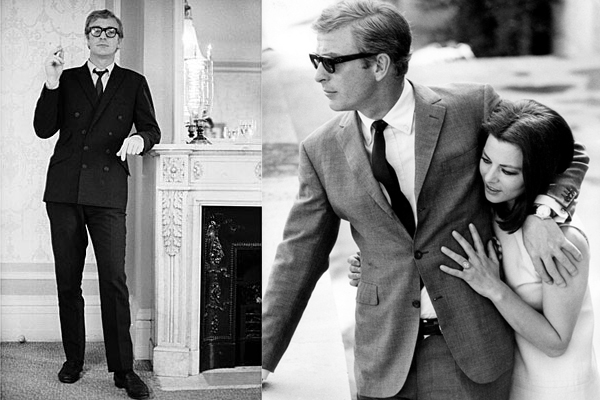
Eight buttons instead of the usual six adds a little bit of extravagance to Michael Caine’s outfit on the left, but it also ensures it will look dated shortly after the picture is taken. On the right, Caine’s jacket is conservative in both lapel and cut and would not look out of place on the streets on London today.
The example of jeans is an excellent one to illustrate my point. The movement from blue collar to ubiquitous represents a slow evolution, at least half a century. Within that slow movement, you have jumps from high-waisted acid wash to baggy and sagging to ball crushing skinny. But amidst all that fluctuation, there was a steady change in some mean.
When I talk about looking back at a picture from 20 years previously, I’m not expecting to see an outfit I’d still be happy to wear (though that would certainly be nice), but at the same time, it’s entirely reasonable to expect to see something I wouldn’t laugh at. I don’t think this is so great a restriction as to stifle creativity. It just keeps us from wearing jackets that look like they were meant for women (a la Black Fleece).
Much of how we appreciate art derives from something subconscious, at least in part subjective values subject to change. But the values which change more slowly, they have to be worth more than those here today gone tomorrow.
Tirailleur1: I don’t disagree with your assessment on the varying lengths of shelf life between new concepts and what we deem as “tried and true.”
It’s funny that you mention Thom Browne and his work at Black Fleece because in my opinion, his silhouette could possibly become the standard of the future. As my definition of standards in terms of fashion it hits all the prerequisites. It started off as an off kilter concept that deviated from the “classic” form of suiting. The jackets are cut short, and the pants are raised to flood levels.

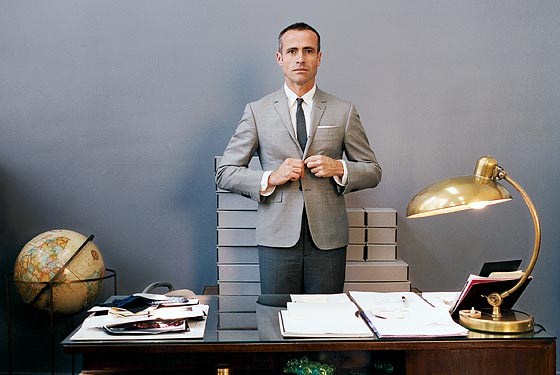
If you were to look at most contemporary suits today, you can clearly see his aesthetics within them. It’s well on its way to becoming the standard. Most men our generation like shorter jackets. Cuffed pants aren’t abnormal anymore, and a lot of us prefer our hems with a slight to no break. Of course his original idea is not the mainstream but it has impacted it enough to see the influence. That is how we develop standards. The innovators work, the taste makers choose and the late adopters introduce it to the mainstream, which then becomes part of the consciousness. In my opinion no person has impacted mens clothing more than Thom Browne (Save for Hedi Slimane, who at Dior Homme changed the way people approached the male figure) in the last 10-15 years
If not for Thom Browne, Suit Supply doesn’t make these
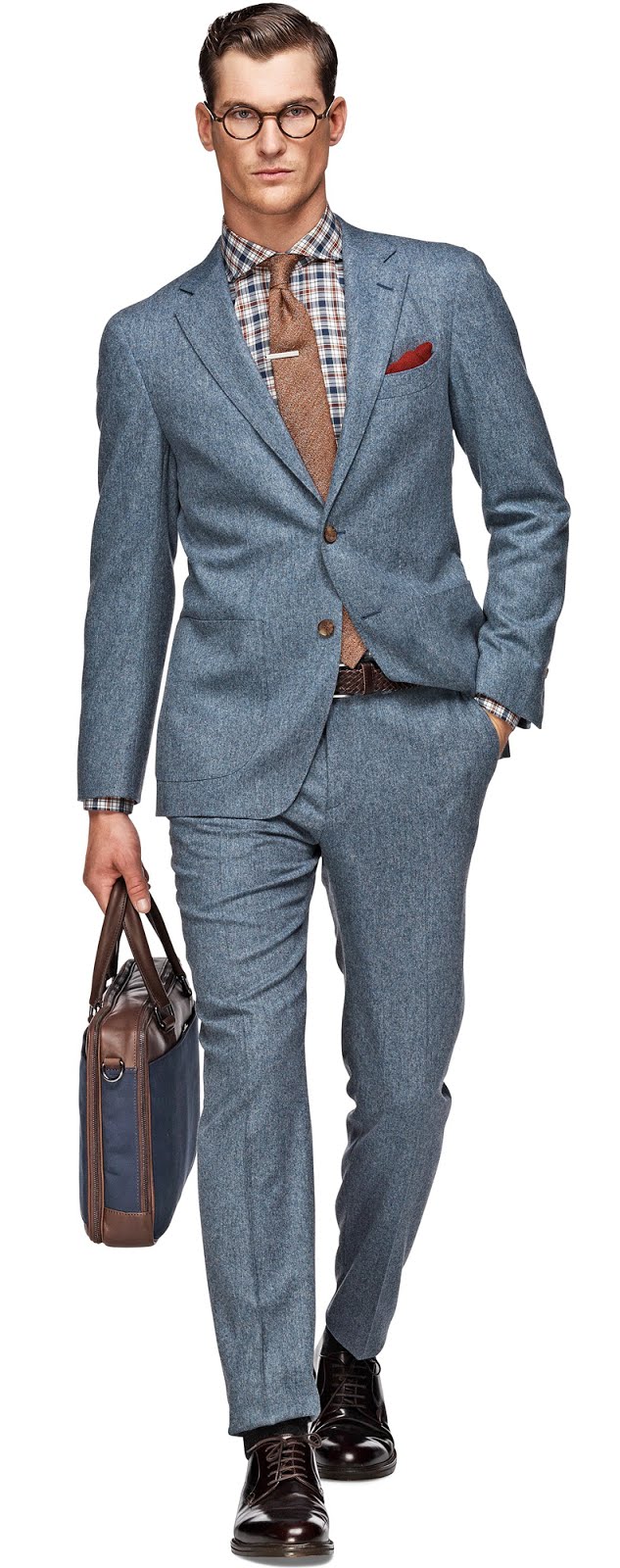

Same with Brooks Brothers
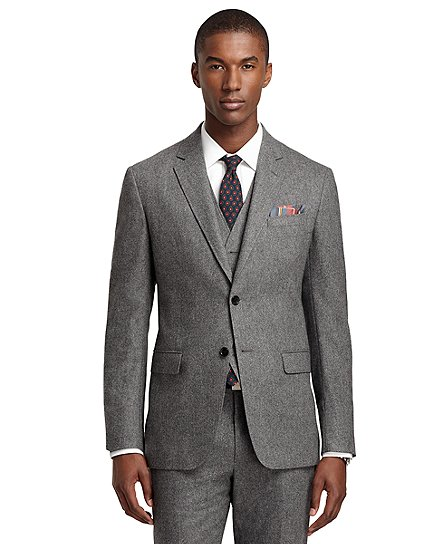
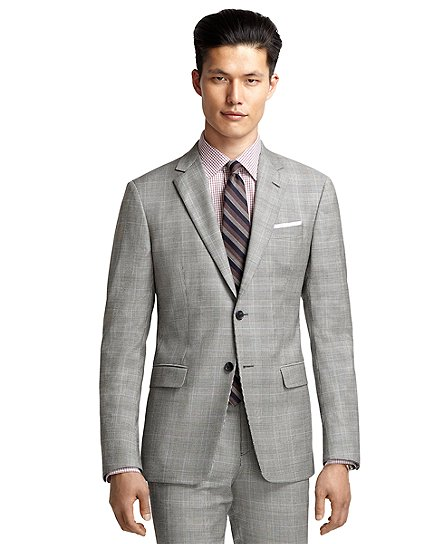
Claghorn: Those Brooks Brothers examples seem exceptional rather than representative, with most of their jackets being longer, but I definitely see your point with regards to Suit Supply (and note that their jackets still cover the asses of their models).
There is a place in the fashion world for the Thom Brownes. They provide the extremes to which the mean responds. But as you mentioned earlier, style fluctuates wildly. At some point the extreme will pivot around the mean and we’ll see wider lapels and lower buttoning points. All the while, that nice happy middle ground will shift slightly to the left or to the right.
On a specific note, I don’t think the short jacket will ever become the norm. It is simply too unflattering on the bodies of the majority of the suit wearing public.
You wrote that Browne’s work meets your requisite of standards, that which society accepts as standards, and you explained how you see standards evolving (which I think we agree upon), but I’m not quite sure you ever explicitly laid out a standard by which we can gauge the quality of an outfit, at least with regards to choice if not to execution.
Tirailleur: Here is the thing, there isn’t a set way of gauging such. The volatile nature of these standards and their evolution make it pretty difficult to do so. Throw in the the matter of subjectivity, cultural differences and sartorial abstract entities and we have a mess on our hands.The only way I can personally estimate what looks good is to take the all those things into context and try to understand what the wearer is trying to convey. Rubric is for pussies.
Tira and Clag: Discussing **** Civilly--How to judge an outfit
To some extent, I can make a disinterested judgment of my outfit on any given day, but there is always going to be some feature I misjudge, whether due to oversight or bias, that another might catch. This much is clear. What is interesting is how we go about assessing the quality of an outfit. This is made more complex by the rapidly changing values of fashion (or style). I look back at what I wore in college and blush at the ridiculousness of some of it (I was generally pretty conservative, but my sister was a model and sometimes provided me with more fashion forward designer clothing which was “carelessly left” on the set). These days, I want to avoid that possibility. Twenty years from now, I want to look at most of my pictures and think “Damn, I was well dressed” and not “Jesus, what was I thinking?” This is the standard I have in mind when I judge what I wear and often with what others wear. I realize it may not be the only standard (nor is it one that many would even care about), but as it addresses temporal relativism, it’s probably the best standard.
Tirailleur1: I realize your newfound goal to not embarrass your future self, but let’s face it, that **** is kinda inevitable. Cutting down your sartorial liberal choices won’t likely change that. Why? Well because as we grow as individuals and as a society, our standards change and evolve. Styles come and go, new silhouettes emerge and new traditions are born . Who is to say the tie does not become a pointed relic five/ten/twenty years from now? Do we really think that all of our odd jackets are bound to survive through the fabric of time itself? Are we really not going to consider the double breasted suit a high contender for future ridicule? As the dial of fashion continues to move so should we. We all should be aware of the possibility of these changes and be prepared to either accept what’s coming or **** our wrists and bleed to death of nostalgia. You don’t avoid using the latest smartphone or laptop just because the idea might seem silly 20 years from now. So why do the same with clothing?
Now there is a difference in trends and the evolution of standards. Trends try to make sense of the zeitgeist. While some succeed in doing so, most of them fail horribly. Standards- or as some would say- “Classics” are the canonical platforms that society chooses to use as doctrine. It first develops as an idea or thing and then somehow gradually becomes the accepted dogma of society. Decades ago jeans were for blue collar workers and poor people. Today, most people have at least a pair of jeans in their closet. And it would not surprise me if it were the most expensive item of clothing they posses.
Alot of us in the classic menswear realm tend to believe that our studied calculations of “boring” will guarantee us a spot in the pantheons of the style gods. I say worrying about such things actually does the opposite. Most of the well dressed people I know disregard such reasoning. Yes, they are aware of the risks, but they don’t allow that factor to hinder them from expressing themselves through dress. We don’t know what the future holds, and we need not worry how our future selves view us. Chances are they will still laugh regardless.
Claghorn: Yes, we don’t know where style will trend in the future, and the further the horizon, the greater distance some future norm will be from the present’s. At the same time, you can’t tell me that something like skinny jeans will outlast double breasted jackets. Both will likely change, but as one is rooted in tradition, the change is much more gradual. Provided that a suit remains firmly within some middle ground (lapels not too wide nor too narrow, gorge not too high nor too low), it will have a much longer shelf life than Justin Beiber’s dropcrotch pants (to provide a rather unfair example) or the elegant work of Yohji Yamamoto (to provide a fairer one). A jacket from Brooks Brothers Black Fleece will look dated far before its more conservative brethren in the Golden Fleece line. Simply because nothing is permanent doesn’t mean nothing can be judged on longevity.
Eight buttons instead of the usual six adds a little bit of extravagance to Michael Caine’s outfit on the left, but it also ensures it will look dated shortly after the picture is taken. On the right, Caine’s jacket is conservative in both lapel and cut and would not look out of place on the streets on London today.
The example of jeans is an excellent one to illustrate my point. The movement from blue collar to ubiquitous represents a slow evolution, at least half a century. Within that slow movement, you have jumps from high-waisted acid wash to baggy and sagging to ball crushing skinny. But amidst all that fluctuation, there was a steady change in some mean.
When I talk about looking back at a picture from 20 years previously, I’m not expecting to see an outfit I’d still be happy to wear (though that would certainly be nice), but at the same time, it’s entirely reasonable to expect to see something I wouldn’t laugh at. I don’t think this is so great a restriction as to stifle creativity. It just keeps us from wearing jackets that look like they were meant for women (a la Black Fleece).
Much of how we appreciate art derives from something subconscious, at least in part subjective values subject to change. But the values which change more slowly, they have to be worth more than those here today gone tomorrow.
Tirailleur1: I don’t disagree with your assessment on the varying lengths of shelf life between new concepts and what we deem as “tried and true.”
It’s funny that you mention Thom Browne and his work at Black Fleece because in my opinion, his silhouette could possibly become the standard of the future. As my definition of standards in terms of fashion it hits all the prerequisites. It started off as an off kilter concept that deviated from the “classic” form of suiting. The jackets are cut short, and the pants are raised to flood levels.
If you were to look at most contemporary suits today, you can clearly see his aesthetics within them. It’s well on its way to becoming the standard. Most men our generation like shorter jackets. Cuffed pants aren’t abnormal anymore, and a lot of us prefer our hems with a slight to no break. Of course his original idea is not the mainstream but it has impacted it enough to see the influence. That is how we develop standards. The innovators work, the taste makers choose and the late adopters introduce it to the mainstream, which then becomes part of the consciousness. In my opinion no person has impacted mens clothing more than Thom Browne (Save for Hedi Slimane, who at Dior Homme changed the way people approached the male figure) in the last 10-15 years
If not for Thom Browne, Suit Supply doesn’t make these
Same with Brooks Brothers
Claghorn: Those Brooks Brothers examples seem exceptional rather than representative, with most of their jackets being longer, but I definitely see your point with regards to Suit Supply (and note that their jackets still cover the asses of their models).
There is a place in the fashion world for the Thom Brownes. They provide the extremes to which the mean responds. But as you mentioned earlier, style fluctuates wildly. At some point the extreme will pivot around the mean and we’ll see wider lapels and lower buttoning points. All the while, that nice happy middle ground will shift slightly to the left or to the right.
On a specific note, I don’t think the short jacket will ever become the norm. It is simply too unflattering on the bodies of the majority of the suit wearing public.
You wrote that Browne’s work meets your requisite of standards, that which society accepts as standards, and you explained how you see standards evolving (which I think we agree upon), but I’m not quite sure you ever explicitly laid out a standard by which we can gauge the quality of an outfit, at least with regards to choice if not to execution.
Tirailleur: Here is the thing, there isn’t a set way of gauging such. The volatile nature of these standards and their evolution make it pretty difficult to do so. Throw in the the matter of subjectivity, cultural differences and sartorial abstract entities and we have a mess on our hands.The only way I can personally estimate what looks good is to take the all those things into context and try to understand what the wearer is trying to convey. Rubric is for pussies.
Last edited:
![Lurker[1] :lurk: :lurk:](/styleforum_ads/smilies/lurker[1].gif)


